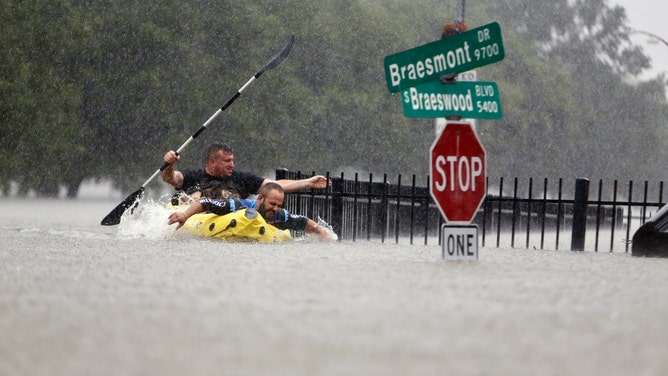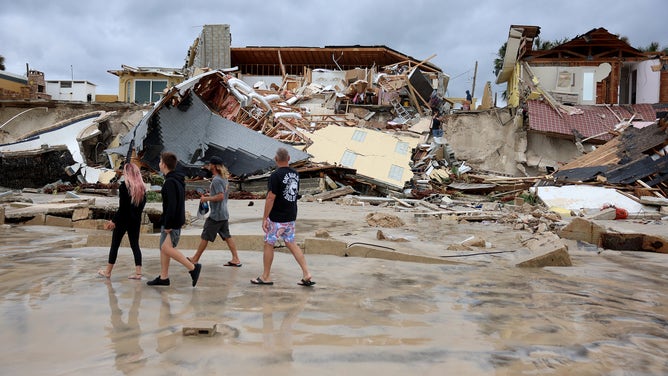FEMA could run out of disaster aid funds by height of hurricane season, agency warns
FEMA projects its Disaster Relief Fund will be out of money by August and running at a $6.3 billion deficit by the end of the fiscal year.
Can FEMA afford another year of 20-something billion dollar disasters
The U.S. has already endured 11 weather and climate disasters, according to NOAA. Some reports say that FEMA could run out of funding by August, in the height of hurricane season. FOX Business Contributor Scott Martin looks in to if FEMA can afford another record year of billion dollar disasters.
WASHINGTON – FEMA's budget shows its Disaster Relief Fund (DRF) running dry in August, at the height of an Atlantic hurricane season that the National Hurricane Center forecasts to be "very busy."
By the end of the fiscal year on Sept. 30, FEMA expects to run at a $6.281 billion deficit. This estimate is based on a 10-year average. But FEMA is coming off 2023, which set a record for the highest number of billion-dollar disasters, costing $92.9 billion.
"Since the beginning of 2023, FEMA has projected that DRF balances are insufficient to meet requirements," the agency said in a statement. "To mitigate this risk, FEMA has prioritized an effort to identify and recover excess funds from previously obligated contracts, grants, and mission assignments. Through these efforts, FEMA has recovered over $6 billion. FEMA will continue to recover unneeded funds, however, recoveries will not be sufficient to prevent the DRF from running out of money."
NOAA: US SEES RECORD NUMBER OF BILLION-DOLLAR WEATHER-CLIMATE DISASTERS IN 2023

The Disaster Relief Fund balance is exhausted in August.
(FEMA / FOX Weather)
Near-record number of costly disasters already in 2024
Already in 2024, the U.S. has seen 11 billion dollar disasters through May. That is just two behind the same period of record-setting 2023. However, FEMA covers more than just NOAA's billion-dollar disasters. Governors can file disaster requests after the president makes a federal disaster declaration.
Even assuming FEMA spending this year wouldn't exceed the 10-year average, FEMA projected the disaster budget to fall $1.439 billion short.
When the fund runs out of money, the agency implements Immediate Needs Funding (INF).
US ENDURED 11 BILLION-DOLLAR DISASTERS IN 2024 SO FAR, AND MOST HAPPENED IN SPRING

FILE - In this Sunday, Aug. 27, 2017. file photo, two kayakers try to beat the current pushing them down an overflowing Brays Bayou from Tropical Storm Harvey in Houston, Texas. FEMA implemented INF after Harvey.
(Mark Mulligan, ASSOCIATED PRESS)
"When the DRF is projected to be insufficient to meet all Stafford Act requirements, FEMA must prioritize lifesaving and life-sustaining activities," FEMA reported in a statement. "Under INF, FEMA prioritizes response and urgent recovery efforts without any interruption. However, new obligations not necessary for lifesaving and life-sustaining activities will be paused."
That means repairing and restoring public infrastructure, hazard mitigation, financial assistance to disaster survivors and Fire Management Assistance Grants will be on hold. FEMA covers about 75% of infrastructure rebuilding, according to Politico. Covering costs of home repair, personal property replacement along with debris clearing will also take a back seat.
"The question is, what happens if they go in the red?" asked FOX Business Correspondent Ashley Webster. "Well, then it's not going to turn around and say, sorry, we've run out of money. They will find the money for it. They will be funded by Congress, but that means areas elsewhere will probably have to suffer."
Could FEMA run out of cash at the height of hurricane season?
FOX Business Correspondent Ashley Weber says FEMA could run out of funding in August, the height of hurricane season. FOX Weather's Robert Ray takes a look at what one city is planning to not need FEMA help in the future.
Not the first time FEMA ran out of money
FEMA is no stranger to asking Congress for more cash. Just look to last year to find the last deficit.
"If you remember, about August of last year, Hurricane Idalia coming into Florida's Big Bend was very catastrophic, very expensive, billions of dollars. And then in that same time period, you had wildfires that absolutely devastated areas in Maui," Webster continued. "Those two events alone were incredibly expensive, as people were trying to put their lives back together and communities put their infrastructure back together. So, based on that, they ran out of money last year and had to rely on an extra $16 billion from Congress to be put back into the budget."
Since 2001, FEMA dropped into the red eight times and implemented the INF – 2003-2006, 2009-2011 and 2017. The agency implemented the emergency plan in 2017 after Hurricane Harvey and in 2005 after hurricanes Katrina, Rita and Wilma.
More funding might be tight in election year
FOX Business Contributor Scott Martin worries that money won't be as easy to come by for FEMA in this election year.
"So FEMA has some work to do. Diane Criswell, who is the head of FEMA, is going to have to go to Congress, I think, sooner than later, and talk about getting some more funding," Martin said. "And the difficulty is this is an election year. You're going to have to talk to, say, the Transportation Department, the Transportation Authority, Housing and Urban Development to get the money in the funding through revenue sharing and things like that."
Several Members of Congress share his fears.
"As the only former emergency management director in Congress, I'm especially concerned with the financial state and the finances of making sure that Congress provides the resources needed (for FEMA) to respond to this hurricane season," U.S. Rep. Jared Moskowitz, of Florida, said at a press conference last month.

FILE: Homes are partially toppled onto the beach after Hurricane Nicole came ashore on November10, 2022 in Daytona Beach, Florida. Nicole came ashore as a Category 1 hurricane before weakening to a tropical storm as it moved across the state. (Photo by Joe Raedle/Getty Images)
(Joe Raedle / Getty Images)
"We know that FEMA's disaster relief fund is going to run out in mid-August, right in the middle of hurricane season. Same thing happened last year. Last year we were on a bipartisan basis," Moskowitz continued. "We were able to pass the FEMA supplemental. FEMA provides lifesaving resources to areas impacted by disasters all around the nation. Emergency management cannot be something that gets caught up in today's partisan politics."
"It's going to come from the taxpayer ultimately and through grants and things like that and other funding ways that FEMA's going to, frankly, have to come up with some organic ways to raise some cash," Martin said. "And so it's concerning."
Hurricanes accounted for 44% of DRF spending from 1992-2001, so lawmakers are concerned about the expanding deficit. Most spending occurs within three years of the disaster but can continue for more than a decade after the event, according to the Congressional Budget Office.

